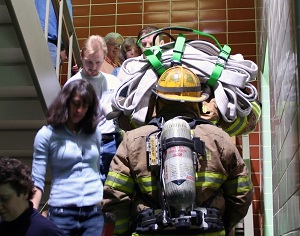 Friday, April 26, 2024
Friday, April 26, 2024  Friday, April 26, 2024
Friday, April 26, 2024 
Ultimately the objective of evacuations when a fire strikes in a building is to ensure safe passage of occupants to the outdoor assembly areas. Of course, the start of any fire in a building must be detected as quickly as possible, and certainly before it can make the means of escape unusable. In some circumstances, particularly where occupants are located away from the origin of the fire and there is a reasonable possibility that it could spread, this means that the fire must be detected and all occupants alerted immediately. The evacuation procedures are based on whether the building is equipped with a single or two stage fire alarm system. The alarm system and evacuation procedures are defined in the approved fire safety plan, along with the special methods of evacuation for persons requiring assistance. The plan also contains the maintenance requirements for the smoke control devices, fire dampers and any automatic or semi-automatic means of fire control. It is essential that this equipment is fully functional to ensure that occupants are enabled to safely exit the building without being overcome by smoke. Stairways are also an integral part of the protected mean of egress, as they provide a connection between floors and are constructed with a much higher fire-resistance rating.
Despite the provisions of protection specified in the codes, walls with openings inherently have less fire resistance. Fire rated doors have a key role, so it is important to ensure they are unobstructed and fully clear on both sides of the opening. If an emergency exit must prevent access from the exterior for security reasons, regulations specify installation of approved alarm panic hardware latches so that it can be opened from the inside without requiring that it be unlocked first. On these doors, applicable signage is to be posted stating “Emergency Exit Only – Alarm Will Sound”. Fire doors which are magnetically locked are to be released upon activation of the fire alarm system and/or activation of a fire pull station located by the exit door. If there are doors that could be mistaken for passage to the outside, signage is to be posted on the door stating “Not An Exit”.
As per the Fire Code 2.8.2.1. (4), the fire safety plan shall be reviewed as often as necessary, but at least every 12 months, and shall be revised as necessary so that it takes into account changes in the use or other characteristics of the building or premises.